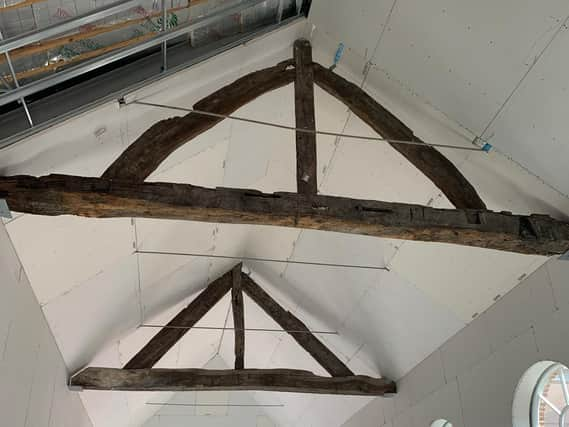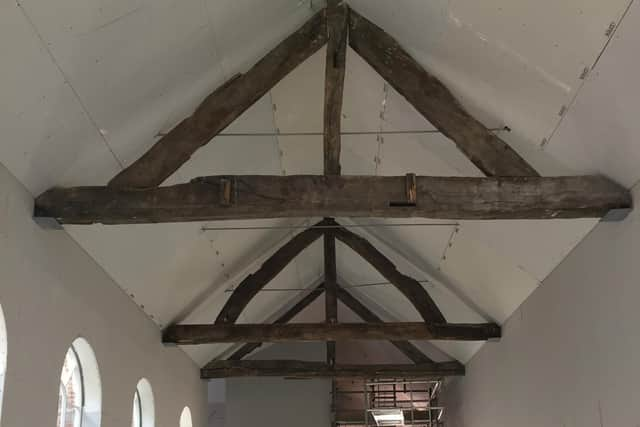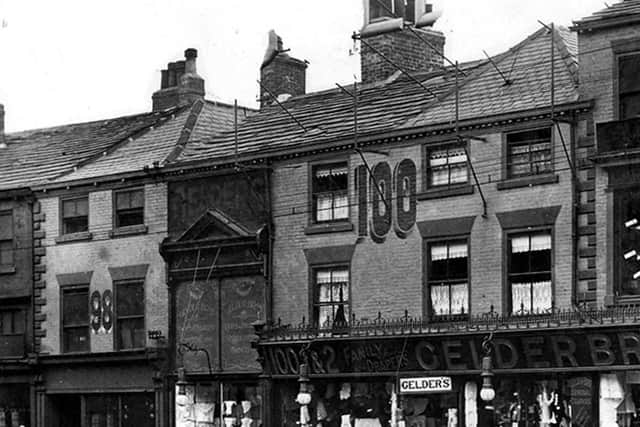Historic oak timber trusses given pride of place in First White Cloth Hall restoration in Kirkgate


The 18th-century First White Cloth Hall in Kirkgate was a cloth trading exchange built for merchants and is the only surviving cloth hall in Leeds.
Rushbond bought the building in 2017, and contractors HH Smith and Sons Ltd began work to revitalise it in March 2019, after receiving funding from the National Lottery and Historic England.
Advertisement
Hide AdAdvertisement
Hide AdIn February, contractors discovered oak wooden trusses that they believe are more than 500 years old.


The trees had been felled in 1470, and were used in another building before being 'recycled'.
Since then, the trusses have been painstakingly restored and this month were installed back into the building by developers Rushbond.
Director of real estate at Rushbond, Mark Finch, said: "As the final work elements at the First White Cloth shape up, we’re delighted that the original trusses, which proved to be so popular with those that have followed the building’s regeneration story, have now been restored and brought back in.
Advertisement
Hide AdAdvertisement
Hide Ad"Huge credit goes to the team who have been able to salvage and repurpose these extraordinary features, to give them a new lease of life for future generations to enjoy.


"The trusses play a big part in the building’s heritage, as part of a philosophy to ensure the designs fuse the ancient with the modern, as a new chapter of the story unfolds.”
Speaking in February, conservation architect Grant Prescott, of Buttress Architects, said: "When construction began, it was clear that the existing structure was in a perilous state.
"The contractors have painstakingly and carefully removed the trusses to store them safely off-site - this has allowed the historic brick and stone walls to be stabilised and incorporated into the final scheme."
Advertisement
Hide AdAdvertisement
Hide AdMr Prescott added: "The analysis has found that whilst there are trusses that date to the original construction of First White Cloth Hall in 1710-11, there were others that could potentially be traced back to the mid-14th century, much earlier than FWCH’s construction - a highly significant discovery.
"The vernacular nature of the timber can be seen in their hand-sawn undulating forms. In light of this, it was seen as vitally important that those timbers are rescued, and the team has worked together to incorporate these within the scheme.
"Due to decay, the trusses will not perform a structural function, but as part of the completed building will provide a fascinating insight into the remarkable historical story of First White Cloth Hall."
The First White Cloth Hall played a key role in establishing Leeds as a dominant force in the textile trade, making it one of the most historic buildings in the city.
Advertisement
Hide AdAdvertisement
Hide AdIt was superseded by the Second White Cloth Hall in Holbeck, which was demolished in 1876, and later the much grander Third White Cloth Hall in Crown Lane, which was partially deconstructed in 1865.
A Forth Cloth Hall was built in 1895 but the decline in the cloth trade meant it was not heavily used and the Hotel Metropole was later built on the site.
This means the First White Cloth hall is the only surviving cloth hall in Leeds, and since its rediscovery and in recognition of its historic importance, the building was Grade II-listed in 1983.
In autumn 2020, builders found a pit, sump and keystone within the structure that were several hundred years old.
Advertisement
Hide AdAdvertisement
Hide AdA keystone is a wedge-shaped stone found at the apex of a masonry arch, and is the final piece placed during construction which fixes the other stones in position.
They often have a decorative role.
Sumps were spaces beneath buildings that were used for drainage.
Developer Rushbond's plans for the Grade II-listed building, which has been on Historic England's At Risk register since 1999, include rebuilding the west wing and creating a large assembly room.
The public courtyard will be enclosed and a new cube will link the site to the Corn Exchange.
Advertisement
Hide AdAdvertisement
Hide AdThey hope First White Cloth Hall, slated for completion in in June 2021, will be leased to a retail store, cultural business or leisure operator.
More in Homes & Gardens: